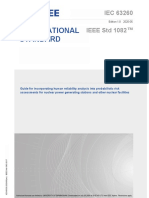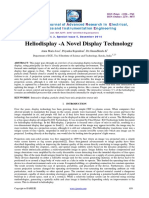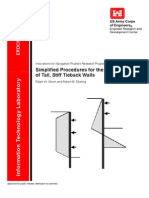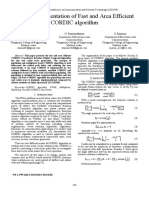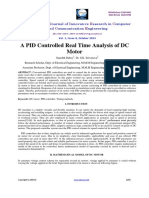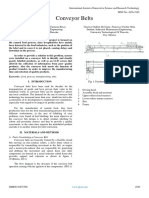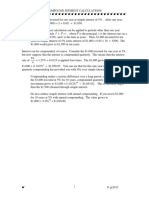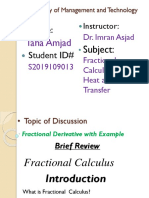Professional Documents
Culture Documents
On Coefficient Estimates For New Subclasses of - Bi-Spirallike Functions
Original Title
Copyright
Available Formats
Share this document
Did you find this document useful?
Is this content inappropriate?
Report this DocumentCopyright:
Available Formats
On Coefficient Estimates For New Subclasses of - Bi-Spirallike Functions
Copyright:
Available Formats
Special Issue-(2nd ICTSA-2022) International Journal of Innovative Science and Research Technology
ISSN No:-24562165
On Coefficient Estimates for New Subclasses of
-Bi-Spirallike Functions
Read. S. A. Qahtan
College Of Engineering
Alrowad University
Taiz, Yemen
Abstract:- In this paper, we introduce and investigate two for functions in these two new subclasses
new subclasses of the function class of - - - for functions.
spirallike functions defined in the open unit disc.
Furthermore, We find estimates on the coefficients Keywords:- Univalent Functions, -Univalent Functions, -
-Spirallike, Subordination, Coefficients Bounds.
I. INTRODUCTION
Let denote the class of functions of the form
Which are analytic in the open disc . Let denote the subclass of function in which are
univalent in and indeed normalized by It is well known that every function has an inverse
defined by
and
A function is said to bi-univalent function in if and are together univalent functions in . Let denote
the class of bi-univalent functions defined in . The inverse function is given by
Spacek [22] introduced the concept of spirallikeness which is a natural generalization of starlikeness. Spirallike functions
can be characterized by the following analytic condition:
A function in is -spirallik if and only if,
Where In [11], Jackson introduced and studied the concept of the -derivative operator as follows :
Equivalently (4), may be written as
Where , note that as
IJISRT22DEC1495 www.ijisrt.com 105
Special Issue-(2nd ICTSA-2022) International Journal of Innovative Science and Research Technology
ISSN No:-24562165
Definition 1.1 Let - - denote the class of - -bi-spirallike functions of order . The
function , given by (1), is said it is in - - if it satisfies:
and
(7)
2 Main Results
Theorem 2.1 Let
Be in - - Then
Where
Proof. Let
is analytic in and satisfies and It can be checked that the function defined
by:
Is a member of the class .
IJISRT22DEC1495 www.ijisrt.com 106
Special Issue-(2nd ICTSA-2022) International Journal of Innovative Science and Research Technology
ISSN No:-24562165
Let
By comparing coefficient in (9), we have
Where
Similarly we take
Where is Analytic in and Satisfies
The function defined by
Is a Member of the class . Let
By comparing coefficient in (13), we have
Where
From (10) and (14) we have
IJISRT22DEC1495 www.ijisrt.com 107
Special Issue-(2nd ICTSA-2022) International Journal of Innovative Science and Research Technology
ISSN No:-24562165
We shall obtain a refined estimate on for use in the estimates of and For this purpose we first add (11) with
(15), then use the relations (17) and get the following:
Putting from (10) we have after simplification:
By applying the familiar inequalities and we get:
and
We next find a bound on . For this we substract (15) from (11) and get
The relation from (17), reduces the above expression to
Using and (18), we get
IJISRT22DEC1495 www.ijisrt.com 108
Special Issue-(2nd ICTSA-2022) International Journal of Innovative Science and Research Technology
ISSN No:-24562165
Where
Therefore, the inequalities and give the following:
Which Simplifies
Now we find an estimate on . At first we shall derive relation connecting and . To this end, Now we
collect (12) and (16) we get
Where
Now we are putting in (21) we get
Where
Substituting from(20) in (21) we get after simplification:
Since , we have
SINCE , WE HAVE
IJISRT22DEC1495 www.ijisrt.com 109
Special Issue-(2nd ICTSA-2022) International Journal of Innovative Science and Research Technology
ISSN No:-24562165
Where
Or
Observing that we have and therefore
We Replace
By the right hand side of (22) ,
put
and
This gives
IJISRT22DEC1495 www.ijisrt.com 110
Special Issue-(2nd ICTSA-2022) International Journal of Innovative Science and Research Technology
ISSN No:-24562165
Where
Next, replacing by the expression in the right hand side of (23) and by (18) we finally get
Where
This Gives
Where
IJISRT22DEC1495 www.ijisrt.com 111
Special Issue-(2nd ICTSA-2022) International Journal of Innovative Science and Research Technology
ISSN No:-24562165
Where
By applying the inequalities we get
Where
IJISRT22DEC1495 www.ijisrt.com 112
Special Issue-(2nd ICTSA-2022) International Journal of Innovative Science and Research Technology
ISSN No:-24562165
As in the above Theorem we get the following:
Corollary 2.1 [21] Let be in - Then
Theorem 2.2 Let , given by (1) in the class . Then
and
Proof. Let , then by Definition 1.1 we have
and
IJISRT22DEC1495 www.ijisrt.com 113
Special Issue-(2nd ICTSA-2022) International Journal of Innovative Science and Research Technology
ISSN No:-24562165
Where
and
As in the proof of Theorem 2.1, by suitably comparing coefficient in (31) and (32) we have
Where and
Where
In order to express interms of and we first add (34) and (37) and get
Again putting from (33) we have
Or equivalently
The familiar inequalities yield
Which Implies that
IJISRT22DEC1495 www.ijisrt.com 114
Special Issue-(2nd ICTSA-2022) International Journal of Innovative Science and Research Technology
ISSN No:-24562165
Following the Lines of Proof of Theorem 2.1, with Appropriate Changes, we Get that
The inequalities yield
We shall next find an estimate on , By substracting (38) from (35) we get
A substitution of the value of from the relation (33) gives
Therefore, using the inequalities , , the estimate for from (41)and the estimate for
from (42), we get
Or equivalently,
As in the above Theorem we get the following:
Corollary 2.2 [21] Let , given by (1) in the class . then
IJISRT22DEC1495 www.ijisrt.com 115
Special Issue-(2nd ICTSA-2022) International Journal of Innovative Science and Research Technology
ISSN No:-24562165
II. CONCLUSIONS [14]. W.C.Ma, D.Minda, A unified treatment of some
special classes of functions, in: Proceedings of the
In this paper, we introduced and investigated two new Conference on Complex Analysis, Tianjin (1992),
subclasses of the function class of - - -spirallike 157-169.
functions defined in the open unit disc. Furthermore, We find [15]. A.K.Mishra and M.M.Soren, "Coefficient bounds for
estimates on the coefficients for functions in bi-starlike analytic functions." Bulletin of the Belgian
these two new subclasses for functions. Future work making Mathematical Society-Simon Stevin,21(1)(2014), 157-
use of the values of a2 a3 and a4 we can caluculate Hankel 167.
determinant coefficient for the bi- spirallike function classes. [16]. G.Murugusundaramoorthy, Subordination results for
spirallike functions associated with Hurwitz-Lerch
REFERENCES zeta function , Integ. Trans., and Special Fns. 23, Issue
2(2012), 97-103.
[1]. I.Aleksandar, The Riemann Zeta-Function: Theory [17]. G.Murugusundaramoorthy and T.janani, Bi- starlike
and Applications, John-Wiley and Sons, Inc., New function of complex order associated with double zeta
York (1985). functions, Afrika Matematika online June(2014).
[2]. E.W.Barnes, The theory of the double gamma [18]. C.Pommerenke, Univalent Functions. Vandenhoeck
function, Philos. Trans. Roy. Soc.,196(1901), 265-387. and Ruprecht,G¨ottingen (1975).
[3]. M.G.Bin-Saad, Hypergeometric seires assotiated with [19]. W.Rogosinski, On the coefficients of subordinate
the Hurwitz-Lerch zeta function, Acta Math. Univ. functions, Proc. London Math. Soc.,48(1943), 48-82.
Comenianae Vol.,2(2009), 269- 286. [20]. S.Siregar, S.Raman, Certain subclasses of analytic and
[4]. D.A.Brannan, T.S.Taha, On some classes of bi- bi-univalent functions involving double zeta functions,
univalent functions, Studia Univ. Babe¸s-Bolyai Inter. J.Advan.Sc.,Eng.and Inform.Tech.,2(5)(2012),
Math.,31(2)(1986), 70-77. 16-18.
[5]. J.Choi, H.M.Srivastava, Certain families of series [21]. M.M.Soren and A.K.Mishra, Coefficient Bounds for
associated with the Hurwitz-Lerch zeta function, Appl. Bi-spirallike Analytic Functions. Kyungpook Math.
Math. Comput.,170(2005), 399-409. J.,58(4)(2018).
[6]. E.Deniz, Certain subclasses of bi-univalent functions [22]. L.Spacek, Prisp vek k teorii funkei prostych, apopis
satisfying subordinate conditions, J. Classical Pest. Math. Fys.,62(1933), 12-19.
Anal.,2(2013), 49-60. [23]. H.M.Srivastava, A.K.Mishra, P.Gochhayat, Certain
[7]. A.Erdelyi, W.Magnus, F.Oberhettinger, F.G.Tricomi, subclasses of analytic and bi-univalent functions,
Higher Transcendental Functions, Vol. I, McGraw- Appl. Math. Lett.,23(10)(2010), 1188-1192.
Hill, New York, Toronto and London (1953).
[8]. B.A.Frasin, M.K.Aouf, New subclasses of bi-univalent
functions, Appl. Math. Lett.,24(2011), 1569-1573.
[9]. S.P.Goyal, P.Goswami, Estimate for initial maclaurian
coefficients of bi-univalent functions for a class
defined by fractional derivative, J. Egyptian Math.
Soc.,20(2012), 179-182.
[10]. R.W.Ibrahim and M.Darus, On operator by double
zeta functions,Tamkang J. Math.,42(2)(2011), 163-
174.
[11]. F.Jackson, On -functions and a certain difference
operator, Trans. Royal Soc., Edinburgh,46(1909), 253-
281.
[12]. T.Janani and G.Murugusundaramoorthy, coefficient
estimates of bi-univalent functions associated with
double zeta functions. International Journal of Pure
and Appl. Math.,101(6)(2015), 903-913.
[13]. R.J.Libera, Univalent -spiral functions, Canad. J.
Math.,19(1967), 449-456.
IJISRT22DEC1495 www.ijisrt.com 116
You might also like
- Ijaerv13n1 - 04 Good PaperDocument9 pagesIjaerv13n1 - 04 Good Paperaakanksha080No ratings yet
- MIPS-Core Application Specific Instruction-Set Processor For IDEA Cryptography Comparison Between Single-Cycle and Multi-Cycle ArchitecturesDocument13 pagesMIPS-Core Application Specific Instruction-Set Processor For IDEA Cryptography Comparison Between Single-Cycle and Multi-Cycle ArchitecturesEng SaziNo ratings yet
- Sic Mos Uis Wipda - Paper - 07102016Document6 pagesSic Mos Uis Wipda - Paper - 07102016terry chenNo ratings yet
- Ieee 1082 Iec 63260 - 2020Document38 pagesIeee 1082 Iec 63260 - 2020Malik AzeemNo ratings yet
- Class 12 Maths Project HelpfulDocument23 pagesClass 12 Maths Project HelpfulParam Waje100% (1)
- VLSI Lab Manual PART-B, VTU 7th Sem KIT-TipturDocument64 pagesVLSI Lab Manual PART-B, VTU 7th Sem KIT-Tipturpramodkumar_sNo ratings yet
- 5 PDFDocument7 pages5 PDFAnonymous NHuqCVE1wNo ratings yet
- Automatic Room Light ControllerDocument7 pagesAutomatic Room Light Controllerhr.muzelloNo ratings yet
- (Lecture 3) Introduction to Electricity System and Improving Energy EfficiencyDocument22 pages(Lecture 3) Introduction to Electricity System and Improving Energy EfficiencyTân NguyễnNo ratings yet
- B00902156_EEE835_Portfolio2Document44 pagesB00902156_EEE835_Portfolio2sholyfilaNo ratings yet
- CSC 2541: Neural Net Training Dynamics: Lecture 1 - A Toy Model: Linear RegressionDocument62 pagesCSC 2541: Neural Net Training Dynamics: Lecture 1 - A Toy Model: Linear Regressiondaveix3No ratings yet
- Robust Filter Design For A Class of Uncertain Chaotic Systems and Its Circuit ImplementationDocument4 pagesRobust Filter Design For A Class of Uncertain Chaotic Systems and Its Circuit ImplementationEditor IJTSRDNo ratings yet
- 02 Using Building EngineDocument26 pages02 Using Building EnginedagushNo ratings yet
- IeeeDocument7 pagesIeeesadouniNo ratings yet
- Experimental ValidationDocument11 pagesExperimental ValidationマルワNo ratings yet
- Heliodisplay A Novel Display TechnologyDocument9 pagesHeliodisplay A Novel Display TechnologyKAMARSU SUMALATHANo ratings yet
- Power Computation of Floating-Point NumbersDocument8 pagesPower Computation of Floating-Point NumbersAnkur PatelNo ratings yet
- Iec 62052-11-2020Document124 pagesIec 62052-11-2020thuahan rathnayakeNo ratings yet
- Coordinate Rotation-Based Design Methodology For Square Root and Division ComputationDocument5 pagesCoordinate Rotation-Based Design Methodology For Square Root and Division Computationpradipta.sarkarNo ratings yet
- Cordic SVD HWDocument6 pagesCordic SVD HWasdf2828No ratings yet
- IJISET-NCISCT-220519Document5 pagesIJISET-NCISCT-220519akshayachu33940No ratings yet
- Design of Chaotic Secure Communication System Based On Laser Dynamic ModelDocument4 pagesDesign of Chaotic Secure Communication System Based On Laser Dynamic ModelEditor IJTSRDNo ratings yet
- Extraction of Series Resistance and Mobility Degradation Parameter in MOSFETs Using Iterative MethodDocument6 pagesExtraction of Series Resistance and Mobility Degradation Parameter in MOSFETs Using Iterative MethodCSIT iaesprimeNo ratings yet
- IEC 62231 Edition 1 0 2006 02Document38 pagesIEC 62231 Edition 1 0 2006 02Bojan MuratovicNo ratings yet
- CEI IEC 62231 Edition 1.0 (2006-02)Document38 pagesCEI IEC 62231 Edition 1.0 (2006-02)antalgergoe50% (2)
- Data Structures and Algorithms - HE12628Document51 pagesData Structures and Algorithms - HE12628Adriana MaziluNo ratings yet
- Architecture Design and Interoperability Analysis of A SCADA System For The Power Network ... (PDFDrive)Document110 pagesArchitecture Design and Interoperability Analysis of A SCADA System For The Power Network ... (PDFDrive)Di PeraltaNo ratings yet
- 1986-Hob Length EffectsDocument2 pages1986-Hob Length Effectsluis_dominguezeNo ratings yet
- Particle Model of LightDocument25 pagesParticle Model of LightInternational Journal of Innovative Science and Research TechnologyNo ratings yet
- Ocni - 2 L: Im Plem Enting C Isco D Ata C Enter N Etw OrkingDocument356 pagesOcni - 2 L: Im Plem Enting C Isco D Ata C Enter N Etw Orkingh3d0nistNo ratings yet
- Lecture 1 Ec3322 Sem I 2008 2009Document46 pagesLecture 1 Ec3322 Sem I 2008 2009Roni SuhandaniNo ratings yet
- A Review On Monitoring Solar System Parameters Using IoTDocument4 pagesA Review On Monitoring Solar System Parameters Using IoTIJRASETPublicationsNo ratings yet
- (Slides) 1 - Basic ConceptsDocument22 pages(Slides) 1 - Basic ConceptsLisa LiNo ratings yet
- Simplified Procedures For The Design of Tall, Stiff Tieback WallsDocument202 pagesSimplified Procedures For The Design of Tall, Stiff Tieback WallsnickrobNo ratings yet
- PV Remote Voltage Monitoring System (Autosaved)Document18 pagesPV Remote Voltage Monitoring System (Autosaved)kennedy lamyaNo ratings yet
- Computer Architecture Technology TrendsFrom EverandComputer Architecture Technology TrendsRating: 4 out of 5 stars4/5 (1)
- Wang 等。 - 2017 - Evolving boxes for fast vehicle detectionDocument6 pagesWang 等。 - 2017 - Evolving boxes for fast vehicle detectionNex VinsNo ratings yet
- Submitted To: Suman Rani, Submitted By:: VishalDocument15 pagesSubmitted To: Suman Rani, Submitted By:: VishalJoginder PannuNo ratings yet
- Modelling and Performance Analysis of A Silicon PV ModuleDocument13 pagesModelling and Performance Analysis of A Silicon PV ModuleKarthik spNo ratings yet
- VolderDocument5 pagesVolderLoc LeNo ratings yet
- ISCPrac 2005 KPDocument6 pagesISCPrac 2005 KPRaghav GogiaNo ratings yet
- IIRfilterdesign FPGADocument10 pagesIIRfilterdesign FPGAJoerg MenkeNo ratings yet
- Experiment 1 - KiCad Introduction and UsageDocument30 pagesExperiment 1 - KiCad Introduction and UsageAnonymous zQ8wOetNo ratings yet
- Salez - Universality of Cutoff For Exclusion With ReservoirsDocument22 pagesSalez - Universality of Cutoff For Exclusion With ReservoirsJoey CarterNo ratings yet
- CS602 Solved MCQs Final Term by JUNAID-1Document39 pagesCS602 Solved MCQs Final Term by JUNAID-1Zee Khan100% (3)
- Chinna Thambi 2014Document5 pagesChinna Thambi 2014DlishaNo ratings yet
- Dennis Jin Development of A Stable Control System For A SegwayDocument25 pagesDennis Jin Development of A Stable Control System For A SegwayIsrael JosueNo ratings yet
- Multimode Optical FiberDocument5 pagesMultimode Optical FiberMaryam AhmedNo ratings yet
- A PID Controlled Real Time Analysis of DC MotorDocument9 pagesA PID Controlled Real Time Analysis of DC MotorBharath PulavarthiNo ratings yet
- Conveyor BeltsDocument6 pagesConveyor BeltsInternational Journal of Innovative Science and Research TechnologyNo ratings yet
- BEC 3253 Production EconomicsDocument4 pagesBEC 3253 Production EconomicsKelvin MagiriNo ratings yet
- A.R. Engineering College, Villupuram Ece Department: Ec2203/Digital ElectronicsDocument8 pagesA.R. Engineering College, Villupuram Ece Department: Ec2203/Digital ElectronicsNitu VlsiNo ratings yet
- MagzineJuly2022 220707 105334Document41 pagesMagzineJuly2022 220707 105334sona swadhina routrayNo ratings yet
- 2020ee31193 Eld411Document6 pages2020ee31193 Eld411yshivshankar81No ratings yet
- SSLC Question Pool Physics - English Medium 1 Mark QuestionsDocument40 pagesSSLC Question Pool Physics - English Medium 1 Mark QuestionsadamNo ratings yet
- Integrated Modular Avionics A380Document85 pagesIntegrated Modular Avionics A380Abhinay YadavNo ratings yet
- Asm1 Dsa Anhdvhbhaf 190004Document39 pagesAsm1 Dsa Anhdvhbhaf 190004Hưng LêNo ratings yet
- On TAMOLED Using NanowireDocument19 pagesOn TAMOLED Using NanowireVignesh Vigi CNo ratings yet
- EC6612 VLSI Design Lab ManualDocument74 pagesEC6612 VLSI Design Lab ManualVijai MeyyappanNo ratings yet
- Icee2022 BousbiaDocument8 pagesIcee2022 BousbiaDjedili AmelNo ratings yet
- Electro-Optics Properties of Intact Cocoa Beans based on Near Infrared TechnologyDocument7 pagesElectro-Optics Properties of Intact Cocoa Beans based on Near Infrared TechnologyInternational Journal of Innovative Science and Research TechnologyNo ratings yet
- Mobile Distractions among Adolescents: Impact on Learning in the Aftermath of COVID-19 in IndiaDocument2 pagesMobile Distractions among Adolescents: Impact on Learning in the Aftermath of COVID-19 in IndiaInternational Journal of Innovative Science and Research TechnologyNo ratings yet
- Formulation and Evaluation of Poly Herbal Body ScrubDocument6 pagesFormulation and Evaluation of Poly Herbal Body ScrubInternational Journal of Innovative Science and Research TechnologyNo ratings yet
- Comparatively Design and Analyze Elevated Rectangular Water Reservoir with and without Bracing for Different Stagging HeightDocument4 pagesComparatively Design and Analyze Elevated Rectangular Water Reservoir with and without Bracing for Different Stagging HeightInternational Journal of Innovative Science and Research TechnologyNo ratings yet
- Drug Dosage Control System Using Reinforcement LearningDocument8 pagesDrug Dosage Control System Using Reinforcement LearningInternational Journal of Innovative Science and Research TechnologyNo ratings yet
- Navigating Digitalization: AHP Insights for SMEs' Strategic TransformationDocument11 pagesNavigating Digitalization: AHP Insights for SMEs' Strategic TransformationInternational Journal of Innovative Science and Research TechnologyNo ratings yet
- A Survey of the Plastic Waste used in Paving BlocksDocument4 pagesA Survey of the Plastic Waste used in Paving BlocksInternational Journal of Innovative Science and Research TechnologyNo ratings yet
- Auto Encoder Driven Hybrid Pipelines for Image Deblurring using NAFNETDocument6 pagesAuto Encoder Driven Hybrid Pipelines for Image Deblurring using NAFNETInternational Journal of Innovative Science and Research TechnologyNo ratings yet
- Design, Development and Evaluation of Methi-Shikakai Herbal ShampooDocument8 pagesDesign, Development and Evaluation of Methi-Shikakai Herbal ShampooInternational Journal of Innovative Science and Research TechnologyNo ratings yet
- A Review: Pink Eye Outbreak in IndiaDocument3 pagesA Review: Pink Eye Outbreak in IndiaInternational Journal of Innovative Science and Research TechnologyNo ratings yet
- Explorning the Role of Machine Learning in Enhancing Cloud SecurityDocument5 pagesExplorning the Role of Machine Learning in Enhancing Cloud SecurityInternational Journal of Innovative Science and Research TechnologyNo ratings yet
- Formation of New Technology in Automated Highway System in Peripheral HighwayDocument6 pagesFormation of New Technology in Automated Highway System in Peripheral HighwayInternational Journal of Innovative Science and Research TechnologyNo ratings yet
- Cyberbullying: Legal and Ethical Implications, Challenges and Opportunities for Policy DevelopmentDocument7 pagesCyberbullying: Legal and Ethical Implications, Challenges and Opportunities for Policy DevelopmentInternational Journal of Innovative Science and Research TechnologyNo ratings yet
- Hepatic Portovenous Gas in a Young MaleDocument2 pagesHepatic Portovenous Gas in a Young MaleInternational Journal of Innovative Science and Research TechnologyNo ratings yet
- Automatic Power Factor ControllerDocument4 pagesAutomatic Power Factor ControllerInternational Journal of Innovative Science and Research TechnologyNo ratings yet
- Studying the Situation and Proposing Some Basic Solutions to Improve Psychological Harmony Between Managerial Staff and Students of Medical Universities in Hanoi AreaDocument5 pagesStudying the Situation and Proposing Some Basic Solutions to Improve Psychological Harmony Between Managerial Staff and Students of Medical Universities in Hanoi AreaInternational Journal of Innovative Science and Research TechnologyNo ratings yet
- Enhancing the Strength of Concrete by Using Human Hairs as a FiberDocument3 pagesEnhancing the Strength of Concrete by Using Human Hairs as a FiberInternational Journal of Innovative Science and Research TechnologyNo ratings yet
- Review of Biomechanics in Footwear Design and Development: An Exploration of Key Concepts and InnovationsDocument5 pagesReview of Biomechanics in Footwear Design and Development: An Exploration of Key Concepts and InnovationsInternational Journal of Innovative Science and Research TechnologyNo ratings yet
- The Making of Self-Disposing Contactless Motion-Activated Trash Bin Using Ultrasonic SensorsDocument7 pagesThe Making of Self-Disposing Contactless Motion-Activated Trash Bin Using Ultrasonic SensorsInternational Journal of Innovative Science and Research TechnologyNo ratings yet
- Supply Chain 5.0: A Comprehensive Literature Review on Implications, Applications and ChallengesDocument11 pagesSupply Chain 5.0: A Comprehensive Literature Review on Implications, Applications and ChallengesInternational Journal of Innovative Science and Research TechnologyNo ratings yet
- Securing Document Exchange with Blockchain Technology: A New Paradigm for Information SharingDocument4 pagesSecuring Document Exchange with Blockchain Technology: A New Paradigm for Information SharingInternational Journal of Innovative Science and Research TechnologyNo ratings yet
- The Effect of Time Variables as Predictors of Senior Secondary School Students' Mathematical Performance Department of Mathematics Education Freetown PolytechnicDocument7 pagesThe Effect of Time Variables as Predictors of Senior Secondary School Students' Mathematical Performance Department of Mathematics Education Freetown PolytechnicInternational Journal of Innovative Science and Research TechnologyNo ratings yet
- Perceived Impact of Active Pedagogy in Medical Students' Learning at the Faculty of Medicine and Pharmacy of CasablancaDocument5 pagesPerceived Impact of Active Pedagogy in Medical Students' Learning at the Faculty of Medicine and Pharmacy of CasablancaInternational Journal of Innovative Science and Research TechnologyNo ratings yet
- Intelligent Engines: Revolutionizing Manufacturing and Supply Chains with AIDocument14 pagesIntelligent Engines: Revolutionizing Manufacturing and Supply Chains with AIInternational Journal of Innovative Science and Research TechnologyNo ratings yet
- Natural Peel-Off Mask Formulation and EvaluationDocument6 pagesNatural Peel-Off Mask Formulation and EvaluationInternational Journal of Innovative Science and Research TechnologyNo ratings yet
- Teachers' Perceptions about Distributed Leadership Practices in South Asia: A Case Study on Academic Activities in Government Colleges of BangladeshDocument7 pagesTeachers' Perceptions about Distributed Leadership Practices in South Asia: A Case Study on Academic Activities in Government Colleges of BangladeshInternational Journal of Innovative Science and Research TechnologyNo ratings yet
- Exploring the Clinical Characteristics, Chromosomal Analysis, and Emotional and Social Considerations in Parents of Children with Down SyndromeDocument8 pagesExploring the Clinical Characteristics, Chromosomal Analysis, and Emotional and Social Considerations in Parents of Children with Down SyndromeInternational Journal of Innovative Science and Research TechnologyNo ratings yet
- Handling Disruptive Behaviors of Students in San Jose National High SchoolDocument5 pagesHandling Disruptive Behaviors of Students in San Jose National High SchoolInternational Journal of Innovative Science and Research TechnologyNo ratings yet
- Beyond Shelters: A Gendered Approach to Disaster Preparedness and Resilience in Urban CentersDocument6 pagesBeyond Shelters: A Gendered Approach to Disaster Preparedness and Resilience in Urban CentersInternational Journal of Innovative Science and Research TechnologyNo ratings yet
- Advancing Opthalmic Diagnostics: U-Net for Retinal Blood Vessel SegmentationDocument8 pagesAdvancing Opthalmic Diagnostics: U-Net for Retinal Blood Vessel SegmentationInternational Journal of Innovative Science and Research TechnologyNo ratings yet
- Robust Reliable Dissipative Filtering For Markovian Jump Nonlinear Systems With UncertaintiesDocument15 pagesRobust Reliable Dissipative Filtering For Markovian Jump Nonlinear Systems With Uncertaintiesbalraj dNo ratings yet
- Mathematics in Chemical EngineeringDocument149 pagesMathematics in Chemical EngineeringDconanNo ratings yet
- Monte Carlo Algorithms for Pi and Sphere VolumeDocument6 pagesMonte Carlo Algorithms for Pi and Sphere VolumePradeep KumarNo ratings yet
- Unconstrained Optimization Methods: Amirkabir University of Technology Dr. MadadiDocument10 pagesUnconstrained Optimization Methods: Amirkabir University of Technology Dr. MadadissNo ratings yet
- Analysis of Vibrational SystemsDocument4 pagesAnalysis of Vibrational SystemskevweNo ratings yet
- Form Finding of Shells by Structural OptimizationDocument9 pagesForm Finding of Shells by Structural OptimizationcaiguiNo ratings yet
- Oscillatory Integrals Lecture NotesDocument33 pagesOscillatory Integrals Lecture NotesLiviu IgnatNo ratings yet
- NUMERICAL METHODS IN QUANTUM MECHANICSDocument101 pagesNUMERICAL METHODS IN QUANTUM MECHANICSAnderson Buarque100% (1)
- Nays2dFlood PDFDocument28 pagesNays2dFlood PDFFranco QuispeNo ratings yet
- Introduction To Finite FieldsDocument26 pagesIntroduction To Finite FieldsPetya ValchevaNo ratings yet
- ch19 PDFDocument23 pagesch19 PDFDonita BinayNo ratings yet
- MTL107 Numerical MethodsDocument3 pagesMTL107 Numerical MethodsHimanshuMeshramNo ratings yet
- Topic 6: Differentiation: Jacques Text Book (Edition 4)Document39 pagesTopic 6: Differentiation: Jacques Text Book (Edition 4)Anas AhmadNo ratings yet
- Real Vector SpacesDocument4 pagesReal Vector SpacesFelix Jonathan100% (1)
- Compound Interest Calculations ExplainedDocument4 pagesCompound Interest Calculations Explaineddev4c-1No ratings yet
- Image Representation and Description: Shahram EbadollahiDocument45 pagesImage Representation and Description: Shahram EbadollahideepakNo ratings yet
- (Dorian Goldfeld) Automorphic Forms and L-FunctionDocument509 pages(Dorian Goldfeld) Automorphic Forms and L-Functioncharlyshaka1No ratings yet
- Building up spacetime with quantum entanglementDocument7 pagesBuilding up spacetime with quantum entanglementHarkeeratNo ratings yet
- Formula 1Document2 pagesFormula 1Sampurna SharmaNo ratings yet
- Beta Distribution SummaryDocument9 pagesBeta Distribution SummaryVarun MunjalNo ratings yet
- Mathematical Physics: Quantities, Vectors, and Coordinate SystemsDocument33 pagesMathematical Physics: Quantities, Vectors, and Coordinate SystemsSk SajedulNo ratings yet
- FYUGP MathematicsDocument51 pagesFYUGP MathematicsISHA BANDONo ratings yet
- Zlib - Pub Nonparametric Statistics 3rd Isnps Avignon France June 2016Document388 pagesZlib - Pub Nonparametric Statistics 3rd Isnps Avignon France June 2016Chaker MeraïhiNo ratings yet
- Computer Programming ENEE 101: Lec#17 (Sequences Part 3)Document11 pagesComputer Programming ENEE 101: Lec#17 (Sequences Part 3)Badr WaleedNo ratings yet
- DAAI - Lecture - 04 - With - Solutions - 10oct22Document84 pagesDAAI - Lecture - 04 - With - Solutions - 10oct22于淼No ratings yet
- Implicit DifferentiationsDocument12 pagesImplicit DifferentiationsKathryn BenizaNo ratings yet
- Anti DerivativesDocument9 pagesAnti Derivativesedmark bonjNo ratings yet
- Name: Student ID#: Dr. Imran Asjad Fractional Calculus and Heat and Mass TransferDocument12 pagesName: Student ID#: Dr. Imran Asjad Fractional Calculus and Heat and Mass TransferNasir AleeNo ratings yet
- Feature Detection - OpenCV 2.4.13.2 DocumentationDocument14 pagesFeature Detection - OpenCV 2.4.13.2 DocumentationgfhjdfNo ratings yet



